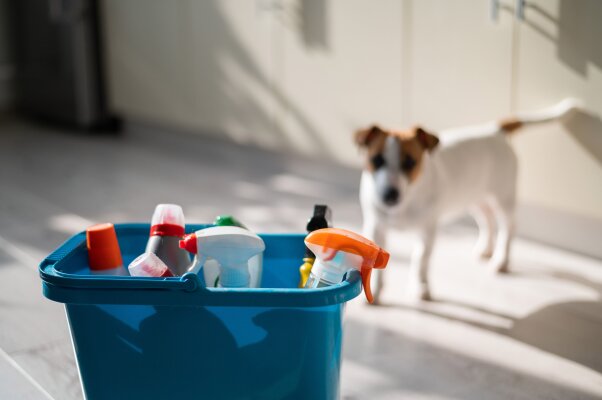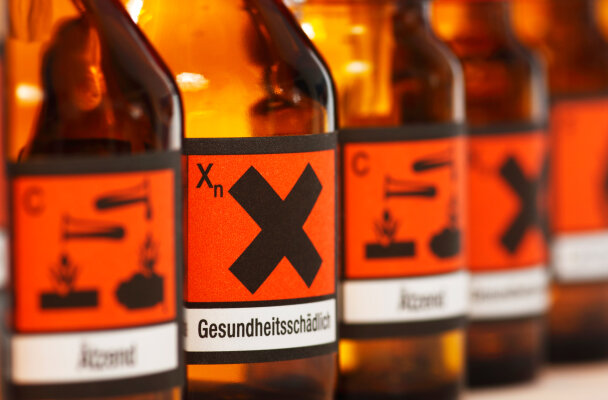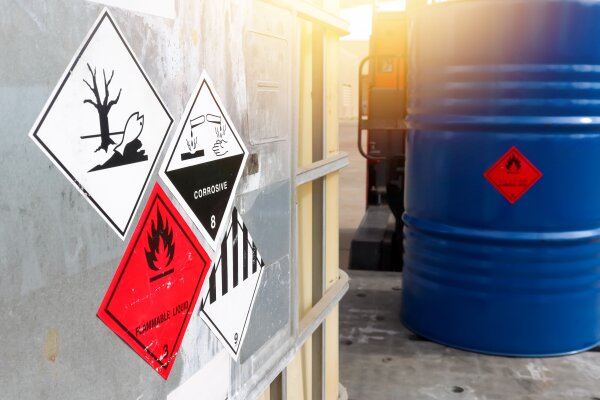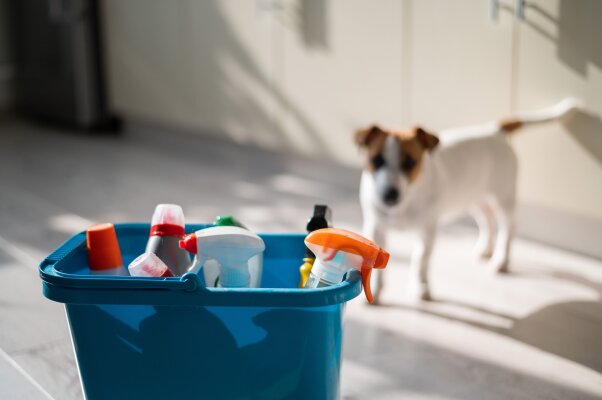Hazardous substances: examples for household and industry

Hazardous substances are substances, materials and products that can have a harmful effect on health and/or the environment. In fact, a whole range of such substances fall into this category – they range from gasoline to cleaning agents to hydrogen peroxides. How these substances are defined, which hazard designation and classification is necessary and which known examples of hazardous substances there are, we have summarized for you here in compact form.
What are hazardous substances? Examples and dangerous goods classes
Hazardous substances are substances, mixtures or products that can have a harmful effect on the human organism or the environment. This includes all substances withtoxic, chemical and/or physical properties that meet the legal criteria of the Ordinance on Hazardous Substances(GefStoffV) and theCLP Regulation (EC) No. 1272/2008.
Typical examples of hazardous substances include nail polish remover, methylated spirits and bleach – substances that we often encounter in everyday life. Since this list is quite long, hazardous materials are further divided into nine hazardous material classes. This facilitates risk assessment, labeling and specification of safety measures in transport and storage.
Hazardous substances: Examples of hazard designations
If hazardous substances are transported, a differentiation must be made between hazardous material and dangerous goods. In principle – all hazardous goods are also hazardous substances, but not all hazardous substances are hazardous goods. The latter is only referred to if there are hazardous substances in the transport, as separate hazardous substance labels become necessary here.
Also, the legal provisions regarding these two groups may differ. If a hazardous substance is to be transported as dangerous goods, the appropriate hazard designations including hazard symbol and abbreviation must be specified. This applies not only to some examples of hazardous substances, but to the entire arsenal. In particular, the following hazard designations can be distinguished:
- Explosive: Substances are considered explosive if they can easily explode and thus present a hazard. They are abbreviated “E” and marked with the symbol of an exploding bomb. Examples of hazardous substances include TNT or glycerol trinitrate.
- Extremely flammable: Extremely flammable substances have a boiling point below 35°C and a flash point below 0°C in the liquid state. The abbreviation “F+” is marked with a flame. Examples are hydrogen and ethyne.
- Highly flammable: If the plus is missing and the abbreviation is given only as “F”, the substances are highly flammable. They can heat up below room temperature and ignite later OR have a flash point below 21°C in the liquid state. Alternatively, they can be ignited as a solid by a fire source OR evolve highly flammable gases when exposed to air or water. The danger symbol is formed by a flame. Examples of substances are ethanol and acetone.
- Fire-promoting: Fire-promoting substances with the abbreviation “O” support combustion without being combustible themselves. A flame over a circle is used as the pictogram. Oxygen and fluorine, for example, are fire-promoting.
- Toxic: Toxic substances may be fatal or cause acute and/or chronic damage to health even in small quantities if swallowed, inhaled or in contact with skin. They are abbreviated with “T” and symbolized with a skull including crossed bones. One toxic hazardous substance example is methanol.
- Very toxic: If substances are given the abbreviation “T+”, they are considered very toxic and the term “very low levels” is added to the above definition. The hazard symbol, however, does not change compared to toxic hazardous substances. Very toxic are, for example, nicotine and heroin.
- Harmful: A black X symbol and the abbreviation “Xn” are used to identify substances that may cause chronic or acute damage to health if inhaled, swallowed or absorbed through the skin. In the past, they were listed under the term “low-toxic”, but now the designation is “harmful to health”. Hazardous substances such as potassium chlorate fall into this category.
- Irritant: Irritant hazardous substances are listed under the identifier “Xi” and the same pictogram. They can cause inflammation in the event of short-term, prolonged or repeated contact with the skin or mucous membranes. For example, sodium carbonate and potassium carbonate are irritant hazardous substances.
- Corrosive: Corrosive substances can destroy living tissue on contact and are identified by a pictogram with a test tube pouring a liquid onto a hand and a black bar. The code letter for this is “C”. Examples of hazardous substances include sulfuric acid and caustic soda.
- Environmentally hazardous: Finally, there are environmentally hazardous substances, which are associated with the code letter “N” and can change water, animals, soil or air, plants, climate or microorganisms in such a way that immediate or subsequent environmental damage is caused. The pictogram shows a dead fish and tree. Potassium permanganate, for example, is dangerous to the environment.
Dangerous goods classes 1-9: Examples of hazardous substances
If hazardous materials are to be transported, they must be labeled as dangerous goods. For this purpose, they are differentiated into nine dangerous goods classes according to ADR(Agreement concerning the International Carriage of Dangerous Goods). Some dangerous goods classes are additionally specified by subclasses. This makes it possible to classify dangerous goods for transport according to their hazard characteristics.
In addition, there are UN numbers that must be indicated on the orange hazard labels. They are used as codes and describe the contents of the transported goods. According to ADR, the following classes are distinguished:
Dangerous goods class 1
Dangerous goods class 1 includes explosive substances and articles containing explosives. They can be activated under pressure, temperature and/or velocity and have a destructive effect on the environment. There are six subclasses for better classification. They are marked with the danger symbol for explosive (E). Examples of hazardous substances in industry include black powder and explosives, and fireworks in the home.
Dangerous goods class 2
Gases and gaseous substancesare grouped together in dangerous goods class 2. They can be further divided into flammable, non-flammable and toxic gases, so that the hazard symbols can range from toxic (T) and corrosive (C) to oxidizing (O) and harmful (Xn). In the household, for example, they can be found as propane gas for camping stoves or as hairspray; in industry, hydrogen is one example of a hazardous substance.
Dangerous goods class 3
If we are talking about dangerous goods class 3, we are talking about flammable liquid substances. Examples of hazardous substances aregasoline, alcohol or heating oil. These substances can be ignited by a certain vapor pressure or flash point and even lead to an explosion. The most common hazard designations are highly flammable (F) or extremely flammable (F+).
Dangerous goods class 4
Flammable solids and articlesare found in dangerous goods class 4, which is therefore also provided with the pictograms for highly flammable (F) or extremely flammable (F+). This class offers three subclasses, facilitating hazardous materials management and transportation in traffic. Typical examples of hazardous substances are matches and pesticides in the householdand white phosphorus, sulfur and sodium in industry.
Dangerous goods class 5
Dangerous goods class 5 is formed by flammable substances, some of which are unstable and can cause or accelerate fires. However, they themselves do not burn. This group includes, in particular, the hazardous substances examples oxygen, some fertilizers, hydrogen peroxide and nitric acid, which are divided into two subgroups:
- Inflammatory substances
- and organic peroxides
The first subgroup is marked with the symbol for oxidizing (O), the second with the symbol for highly flammable (F) or extremely flammable (F+).
Dangerous goods class 6
Dangerous goods class 6 summarizes toxic and infectious substances, which are divided into two subgroups:
- toxic substances (6.1)
- and infectious substances (6.2)
Here are hazardous materials examples such as hospital waste, pathogens, and trash that may be generated during a renovation. Electrical appliances and fluorescent lamps can also fall into this category. It is provided with the hazard symbols for toxic (T) or very toxic (T+). In addition, there is a biohazard marker.
Dangerous goods class 7
Radioactive substances and articles containing such substances are to be found in dangerous goods class 7. The classification here is strongly determined by the categorization of the packaging, so that, for example, shipping packages can be distinguished. Dangerous goods class 7 includes hazardous materials examples such as uranium, plutonium and medical instruments such as X-ray equipment.
Dangerous goods class 8
Dangerous goods class 8contains corrosive substances that have a corrosive effect on mucous membranes or the epithelial tissue of the skin. They can also cause damage to objects or form corrosive vapors under water or humidity. They are marked with the hazard symbol for corrosive (C). Examples of hazardous substances in this category are cleaning agents (such as barbecue cleaners and chlorine) in the home and ozone, sulfuric acid, caustic soda and hydrochloric acidin industry.
Dangerous goods class 9
Finally, there is dangerous goods class 9, which groups together various hazardous substances. Due to their specific criteria, these cannot be classified in any other ADR dangerous goods class and are bundled here. Accordingly, the number of examples of hazardous substances is large. They range from dry ice and asbestos to airbags and lithium batteries.
By the way, you can also find more information and a detailed description of all dangerous goods classes in our guide on this topic – just followthis link.
Examples of CMR hazardous substances
In addition, (proven and potential) carcinogenic, mutagenic and fertility-endangering substances must be listed as CMR substances (“cancerogenic mutagenic reprotoxic”) according to the GHS regulation. They belong to the hazard designations T, T+ or Xn and are differentiated into three categories:
- Category 1: proven from experience in humansCategory
- Category 2: detected in animals, suspected in humans
- Category 3: it is assumed to be so in humans
The correct handling of hazardous substances
Hazardous substances do not bear their name for nothing, because they can lead to accidents, work-related health hazards and occupational diseases. For this reason, the GefStoffV, the CLP Regulation and other legal foundations (such as the Radiation Protection Ordinance (StrlSchV) and the Chemicals Prohibition Ordinance (ChemVerbotsV)) specify many labeling and use regulations.
At the same time, when handling examples of these hazardous substances, care should be taken to ensure absolute safety and an appropriate response in the event of an emergency. This includes requiring all authorized personnel to complete prior safety training and comply with operating instructions at all times. In addition, suitable protective clothing – including respiratory protection for many substances – and ventilation of the storage and work area are required. In addition, avoidance and hazard minimization apply.
Should an accident occur, allaction maxims for the respective hazardous substance must be known and applied. This often includes immediate removal of wetted clothing and cleansing in the emergency shower or with the eyewash device. The required first aid measures according to the operating instructions must be applied.
Hazardous substances: examples can be found in every household
Examples of hazardous substances can be found not only in industry, but also in every household. Therefore, it is important to be familiar with hazard designations and classifications so that you can respond appropriately in an emergency. Hazardous material classes must also be taken into account during transport, which enable a suitable response “on the line”. In this way, you are not only within the legal regulations, but you are also prepared in the best possible way.
FAQ
Hazardous substances are substances, products and mixtures that can have a harmful effecton humans or the environment. These substances may be flammable, oxidizing, toxic, harmful, corrosive, irritant and/or hazardous to the environment. Therefore, many different types of substances can be counted as hazardous substances.
According to GefStoffV, substances and articles are classified as hazardous substances if they comply with § 3 and have physico-chemical, chemical or toxic properties that may pose a hazard. Explosive substances also belong to this category.
The Globally Harmonized System (GHS) establishes the division of hazardous substancesinto 16 hazard classes, replacing the previous European chemicals legislation. In addition, hazardous substances can be classified according to dangerous goods class or hazard designation (such as “toxic” or “harmful”).
Thanks to the many legal obligations for labeling, hazardous substances can be recognized quite easily by hazardous substance symbols and hazardous substance designations. These must be visibly marked on the packaging.
Do you have questions about the topic or would you like to suggest a topic? Please contact us by phone at +49 30 2096579 00 or send us an email at info@medsolut.com.




